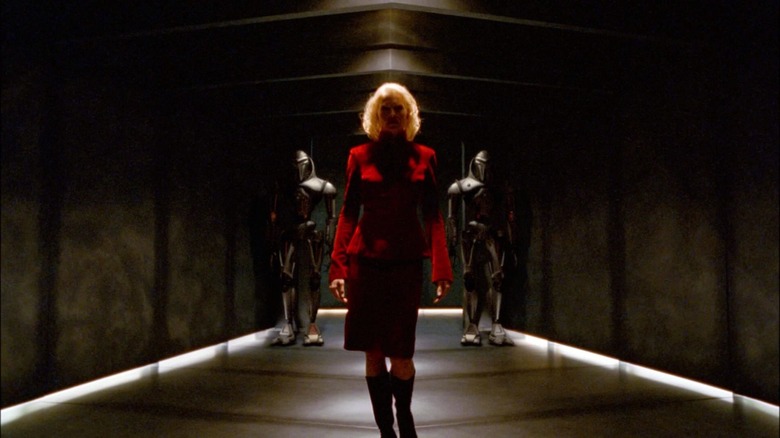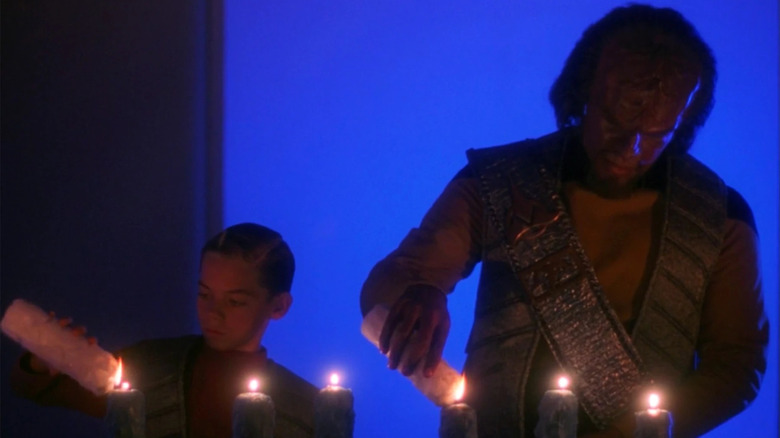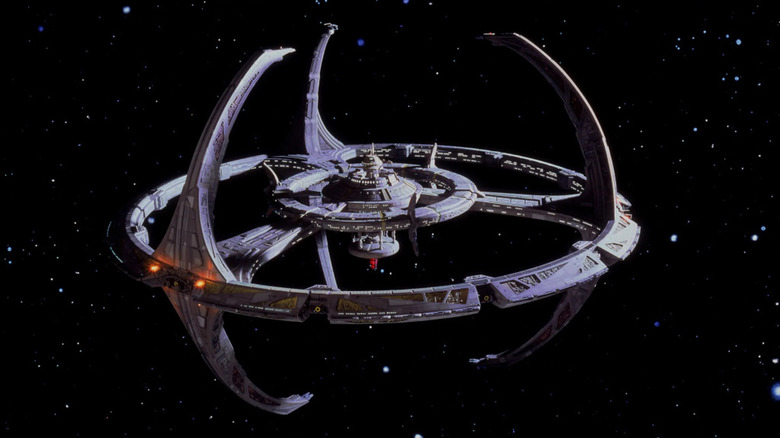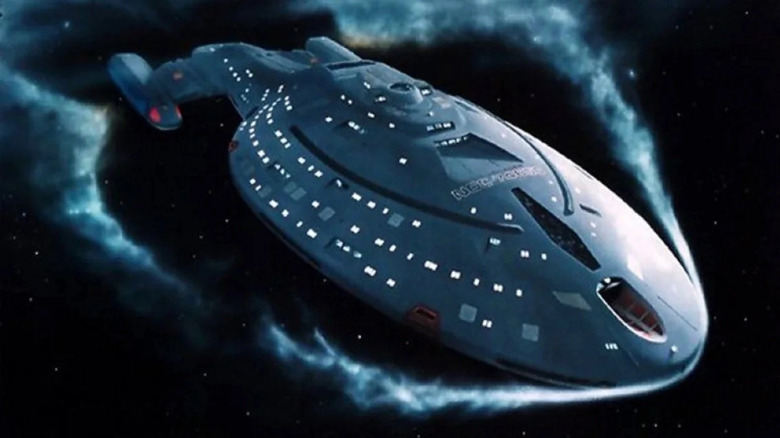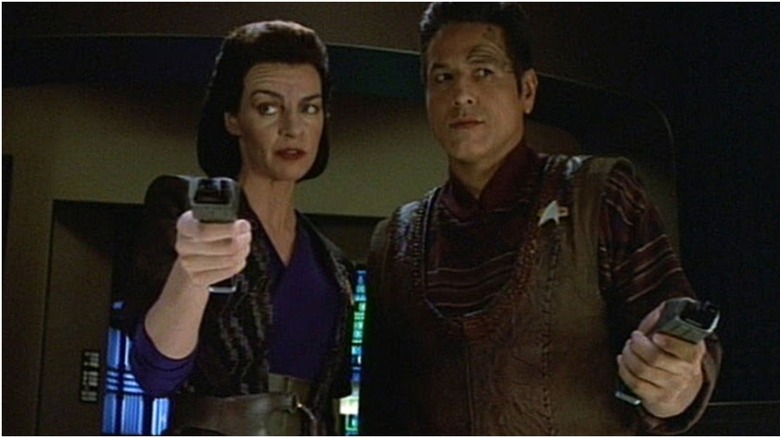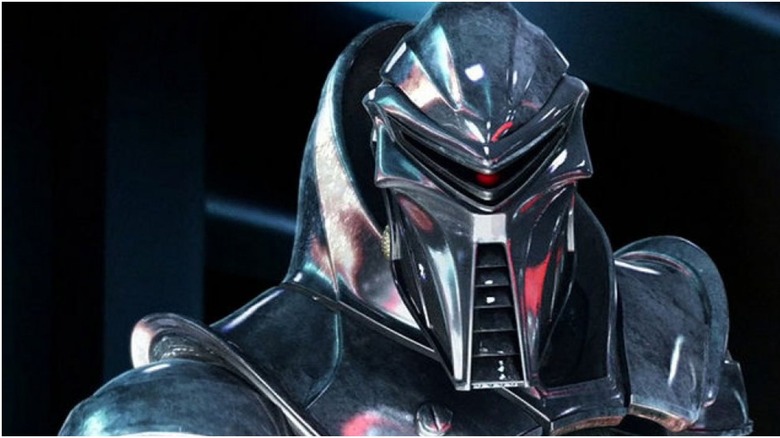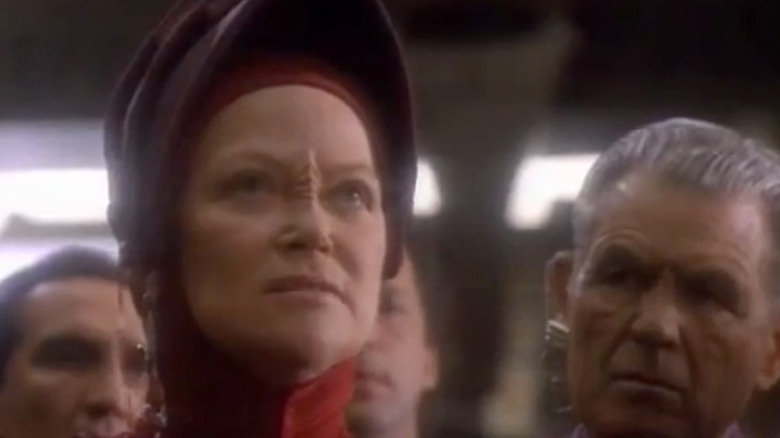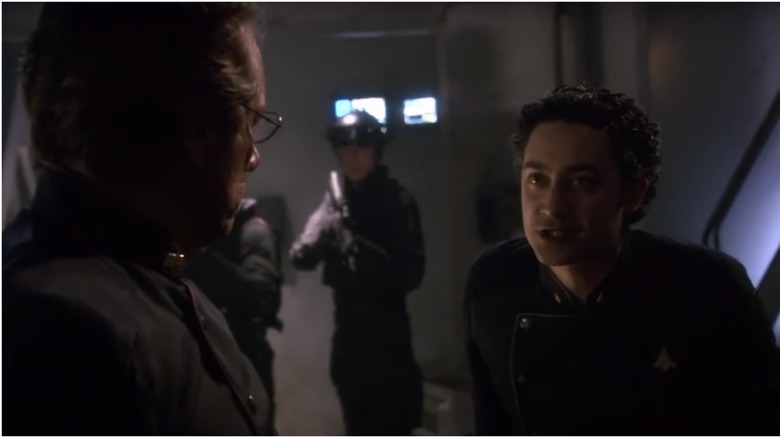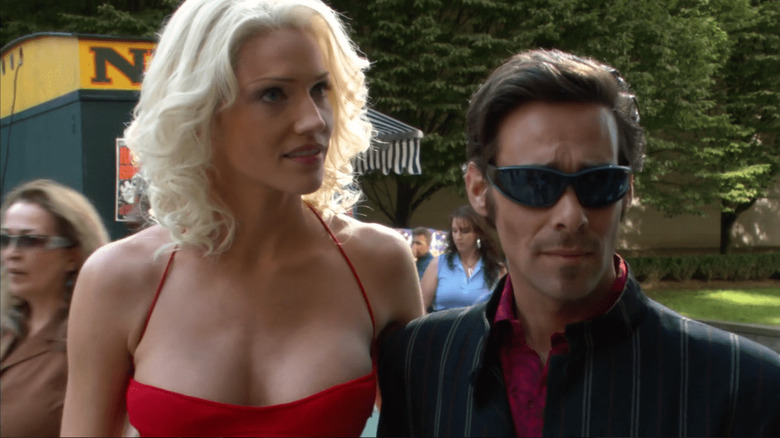The Star Trek Frustrations That Shaped Battlestar Galactica
The best remakes are those that take promising ideas and revamp them with better execution. Case in point: "Battlestar Galactica." The original 1978 series was a kitschy "Star Wars" knock-off, while the 2004 reimagined series is one of the best science-fiction TV shows ever made. The series went to places no previous sci-fi show had dared all while telling a gripping, moving story about humanity and faith. "Battlestar Galactica" producer Ronald D. "Ron" Moore had previously worked on "Star Trek" for a decade. The positives and negatives of his experience shaped "Battlestar Galactica."
How Ron Moore got started
"Star Trek: The Next Generation" famously got off to a rough start — no Trekkie alive lists "TNG" Season 1 as their favorite. Season 2 improved things, with some brilliant episodes like "Q Who" and "The Measure Of A Man," but was a mess behind the scenes. The 1988 Writers Guild of America strike shortened the season, and head writer Maurice Hurley left the series. Michael Piller, who stepped up to replace Hurley, was the one who recruited Ron Moore.
Moore had sent in a spec script titled "The Bonding," about the son of an Enterprise crewmember grieving his mother's death. This story and its exploration of grief offer a human touch that became a calling card of Moore's writing. The script impressed Piller; "The Bonding" became episode 5 of season 3 while Moore joined the "TNG" writers' room. His next episode, "The Defector," about a Romulan admiral who defects to the Federation, was even better.
Moore became one of the show's most prolific writers and was always skilled at bringing the series down to earth. His "TNG" filmography includes "Family," where Captain Picard (Patrick Stewart) visits his family vineyard and processes his trauma over being assimilated by the Borg, and "The First Duty," where Wesley Crusher (Wil Wheaton) faces a moral quandary after a classmate dies in an accident. Moore ultimately wrote 27 episodes and even co-scripted the finale "All Good Things" with Brannon Braga, another young writer whose career was kickstarted when he joined "TNG." After "TNG" concluded, Moore jumped ship to the concurrent "Star Trek" series, "Deep Space Nine." While "DS9" was only possible thanks to "TNG," it was a very different beast.
Deep Space Nine charted its own path
"TNG" was a first-run syndication show; Paramount sold the airing rights for the show directly to local TV station affiliates. This meant the writers approached episodes as if they could be someone's introduction to "Trek"; the most inter-episode continuity came from two-parters. "DS9," on the other hand, used more long-form storytelling. The bulk of the series focused on the build-up to the Federation's war with the Dominion, the ruling power of the Gamma Quadrant; this cold war went hot in "DS9" Season 5 and carried on until the end. All the while, the main cast changed and emerged from the series as different people than they had been at the start. This approach simultaneously made "DS9" more plot and character-driven than the past two "Star Trek" series, which were episodic to their core.
"DS9" also wasn't afraid to go darker places. "Star Trek" has always been humanistic, at times moralistic, and franchise creator Gene Roddenberry wanted the setting to be a utopian vision of human achievement. However, "DS9" seeks to test those ideals rather just demonstrate them.
Season 2 episode "The Maquis" features a rebellion by Federation colonists who are unwilling to cede their land to the Cardassians. As Cpt. Ben Sisko (Avery Brooks) notes in this episode, "it's easy to be a saint in paradise, but the Maquis do not live in paradise." Therein lies the strength of "DS9"; it takes its characters out of their comfort zones and tests how they react. Season 6 episode "In The Pale Moonlight," wherein Sisko conspires to bring the Romulans into the Dominion War, would've been unthinkable with Roddenberry running the ship. After "DS9" wrapped, Moore briefly joined the staff of "Star Trek: Voyager." However, as Moore discovered, this series was a step backward compared to "DS9."
What Voyager could have been
"Voyager" was the third "Star Trek" show created within a decade and needed a hook to stand out from its peers. This hook was that the titular ship was stranded in the far reaches of the Delta Quadrant, light-year upon light-year from Federation space. Two crews, led by Captain Kathryn Janeway (Kate Mulgrew) and Maquis leader Chakotay (Robert Beltran), had to partner to make it back home.
This premise meant "Voyager" held the potential to be the most serialized "Trek" yet. For one, there was a driving goal to the series beyond "go where no one has gone before." Moving the setting away from Starfleet raised the stakes; the Voyager's crew was in a strange, new land with no allies at their beck and call. Not to mention all the potential character conflict from former enemies now working on the same ship towards a common goal. Little to none of this potential was realized.
Rick Berman oversaw "Voyager" alongside a revolving door of showrunners, including the aforementioned Piller and Braga. That turnover alone reflects a show struggling to carve out an identity and an environment non-conducive to creativity. Moore explained in "The Fifty-Year Mission: The Complete, Uncensored, Unauthorized Oral History of Star Trek" (by Mark A. Altman and Edward Gross) that the studio barred the writers from experimenting with the "Trek" formula as "DS9" had. Since "TNG" had been more successful than "DS9," they wanted another "Star Trek" show in that vein, and so that's what "Voyager" became: "TNG" -lite.
Moore's month on Voyager
"Voyager" season 3 episode "Worst Case Scenario" features B'Elanna Torres (Roxann Dawson) discovering a holodeck recreation of a Maquis mutiny on Voyager. This episode can't help but feel like a tantalizing taste of the show "Voyager" could've been.
Moore detailed this problem in the aforementioned "Complete, Uncensored, Unauthorized Oral History":
"When the Maquis put on those Starfleet uniforms at the end of the pilot, the show was dead... It should have been these two sides that were forced to work together that still don't like each other and still are gunning for each other, wondering who's going to come out on top. Who's going to betray who?
Needless to say, Moore didn't last long on "Voyager." He's often recounted his breaking point:
"I started asking questions about B'Elanna, who she is. I was saying, 'I'm having a little trouble watching episodes and getting a handle on her, and what she is about.' The response was, 'We don't have an idea. The past doesn't matter. Just do whatever you want.' What are you talking about? How can you give up on your own show? How do you give up on your characters?"
Moore's departed from "Voyager" in weeks with only 2 episode credits: "Survival Instinct" and "Barge of the Dead." Leaving "Voyager" ended his 10-year run as a writer on "Star Trek." It was not, however, the end of his career in science-fiction television.
Rebooting Battlestar
One of Moore's post "Trek" gigs was the comedy series "Good vs Evil." On that series, he met David Eick, who became his partner in rebooting "Battlestar Galactica" for the 21st century. The pair stripped down the series, removing the goofiness of the original while amping up the melodrama. The villainous Cylons were no longer boxy, monotone-voiced robots but instead artificial humans right out of "Blade Runner." The original Cylons had been alien creations, but Moore and Eick's "BSG" revised their origin. As the opening narration of the reimagined "BSG" said, "the Cylons were created by man." This turned the conflict at the series' heart from humans vs invaders to parents vs children.
The new "BSG" was made in the shadow of 9/11; like all contemporary American pop culture, this shaped the series to its bones. The Cylons' destruction of the 12 colonies hit much closer to home for a 2000s audience than it had for viewers back in the 1970s. It helps that Moore and his writers weren't shy about getting political. For the episode "Litmus," they repurposed a classic "TNG" episode, "The Drumhead." In both episodes, an explosion aboard the ship prompts the formation of an independent tribunal. Justice descends into a witch hunt as the adjudicator goes power-mad. This premise found new resonance because the ink on the PATRIOT act was still wet when "Litmus" aired.
Deep Space Nine's Influence
"DS9" is often cited as the prototype for "BSG," even by Moore himself. In an interview with Empire, he said:
"Being on the writing staff of 'Deep Space Nine' had a huge impact on me and guided my thinking in a lot of ways. It taught me a lot about characters, about making characters more ambiguous. About having complicated moral choices for them, about telling a war story, about trying to tell a war story honestly. Some of them were negative lessons – 'Star Trek's' built in parameters prevented all of us from doing things at 'Deep Space' that we wanted, certain kinds of stories we wanted to tell and there were certain frustrations built into the experience that then became fuel to do it the way I wanted to do it. To tell stories the way we wanted to, to be bolder, to do things the audience wouldn't expect and to take more chances and not be afraid the audience would stop liking your characters if they did ugly things. A lot of those ideas were born out of the frustration of 'Deep Space'."
There's another unifying factor: religion, something Roddenberry was famously antipathetic towards. Braga summed up the "Trek" creator's views as, "On Roddenberry's future Earth, everyone is an atheist. And that world is the better for it." "DS9," on the other hand, focused on the alien faith of the Bajorans. Thus, "DS9" became the first "Star Trek" series to explore religion in any depth. "BSG" followed this path, but made the villains the ones who carried faith; the reimagined Cylons are monotheists and they act only according to the will of their god. As Moore said, "[The Cylons] have aspects of Al Qaeda and they have aspects of the Catholic Church and they have aspects of America."
Battlestar vs Voyager
While Moore worked on "DS9" far longer than "Voyager," it's clear the latter series also had a sizable impact on how he shaped "BSG." On paper, the "Trek" series that "BSG" was closest to was "Voyager." Both shows starred a starship crew, alone against a hostile universe, embarking on a perilous journey towards Earth. The difference is that "BSG" was able to make the most of its premise.
"BSG" was unafraid to rock the boat or shift the status quo, in the process racking up a body count higher than any "Trek" series. There was a much greater sense of consequence on "BSG" than there ever was on "Trek." The opening episodes of "BSG" season 1, "33" and "Water," demonstrate this right off the bat. In the former, Lee "Apollo" Adama (Jamie Bamber) and Kara "Starbuck" Thrace (Katee Sackhoff) are forced to shoot down a civilian ship after it's believed to have been captured by Cylons. The latter centers on the Galactica's search for water, a precious resource in the dark heart of space.
Moore's specific complaint about "Voyager," the lack of character conflict and conflicting loyalties, was embraced in "BSG." At the end of the pilot mini-series, Sharon "Boomer" Valerii (Grace Park) is revealed as a Cylon sleeper agent. She spends season 1 wrestling with her true nature before the finale, "Kobol's Last Gleaming," ends with her shooting Commander William Adama (Edward James Olmos). "BSG" season 4 features an alliance between the humans and a rebel faction of Cylons, but it's far more factional than the Starfleet/Maquis team-up. It even leads to a mutiny on Galactica during two-parter "The Oath" and "Blood on the Scales." What "Voyager" relegated to its holodeck, "BSG" mined for all it was worth with palpable consequences.
A polarizing ending
Now, "BSG" isn't perfect. According to the aforementioned Empire interview, Moore felt by the third season that "BSG" was approaching its end, but he and his team hadn't begun writing with an ending in mind. This led to some questionable twists in the latter half of the show. A running mystery in season 3 was the identity of the "Final Five" Cylons. The answers: Col. Saul Tigh (Michael Hogan), his wife Ellen (Kate Vernon), Galen Tyrol (Aaron Douglas), Samuel Anders (Michael Trucco) and Tory Foster (Rekha Sharma) felt like they'd been plucked from a hat.
The ending was especially polarizing. It turned out the series was actually set millennia in the past; the humans and rebel Cylons name the planet they settle on "Earth" in tribute to the destination they'd long been searching for. The series' final scene is the two angels who appeared as Cylon Number Six (Tricia Helfer) and Gaius Baltar (James Callis) in modern-day New York, contemplating if our civilization will repeat the cycle of machine rebelling against man. They walk off into the crowd as Jimi Hendrix's "All Along The Watchtower" plays.
However, even when the narrative of "BSG" veered off course, the characters and their actors stayed true. The scene in "Revelations" when Tigh confesses his Cylon nature to Adama, his best friend for 30 years, is some of the best work that either Olmos or Hogan put in on the show. If there's one positive lesson Moore learned from "Star Trek," it was that character comes first.
